World Oceans Day through Books: Corals, Oceanography, and the Deep Sea
Darwin and the Theory of Coral Reef Formation: Structure and Distribution of Coral Reefs
Charles Darwin will forever be remembered for his theory of evolution by means of natural selection and the publication of On the Origin of Species in 1859. But Darwin’s scientific contributions extend even beyond this monumental achievement. As an example, Darwin also presented a theory of how coral reefs and atolls are formed.
Coral reefs are underwater ecosystems built by colonies of tiny animals – mostly stony corals – and held together by calcium carbonate structures that these animals secrete. These reefs are home to at least 25% of all marine species. An atoll is a ring-shaped coral reef that encircles a lagoon.
 |
| Distribution of known coral reefs of the world during Darwin’s time, including the types. Darwin, Charles. The Structure and Distribution of Coral Reefs. 1842. http://biodiversitylibrary.org/page/40453231. |
Darwin developed his theory about the formation of coral reefs and atolls during his famous Beagle voyage (1831-36). He published the theory as his first monograph in 1842 as The Structure and Distribution of Coral Reefs, Being the first part of the geology of the voyage of the Beagle, under the command of Capt. Fitzroy, R.N. during the years 1832 to 1836.
The process by which corals and atolls are formed was a popularly-debated scientific question in the early 19th century. Darwin’s coral theory stated that atolls formed from a gradual process from fringing reefs to barrier reefs and finally atolls. As Gordon Chancellor explains in Darwin Online,
“In clean, agitated, tropical seas corals will form fringing reefs just below low tide level. If the coastline is being elevated (as for example may happen if the island is an active volcano) this type of reef should persist but as soon as the living coral is raised above the surf it will die and become a strip of white limestone. If the coastline is stable, the coral will gradually grow out from the shore to become a barrier reef. If the coast is sinking, as Darwin thought was happening to hundreds of islands in the south Pacific, the coral might keep pace by growing upwards but as the land sinks beneath the waves all that would remain would be a more or less circular atoll. Eventually the rate of subsidence might prove too fast, or (perhaps as in our own times of global warming) sea level will rise too fast and the atoll will die.”
Although Darwin’s theory was widely but not universally accepted during his lifetime, modern investigations support his ideas. Coral Reefs also helped establish Darwin’s reputation as a leading scientific mind and helped provde him with the credibility he needed to have his theory of evolution taken seriously. Indeed, Coral Reefs was not only Darwin’s first monograph, but it also demonstrated a common theme throughout all of Darwin’s theories – that gradual change over time, often the result of an aggregation of the individual actions of small organisms, can account for the entire history of our planet and the species, ecosystems, and geological formations we see today.
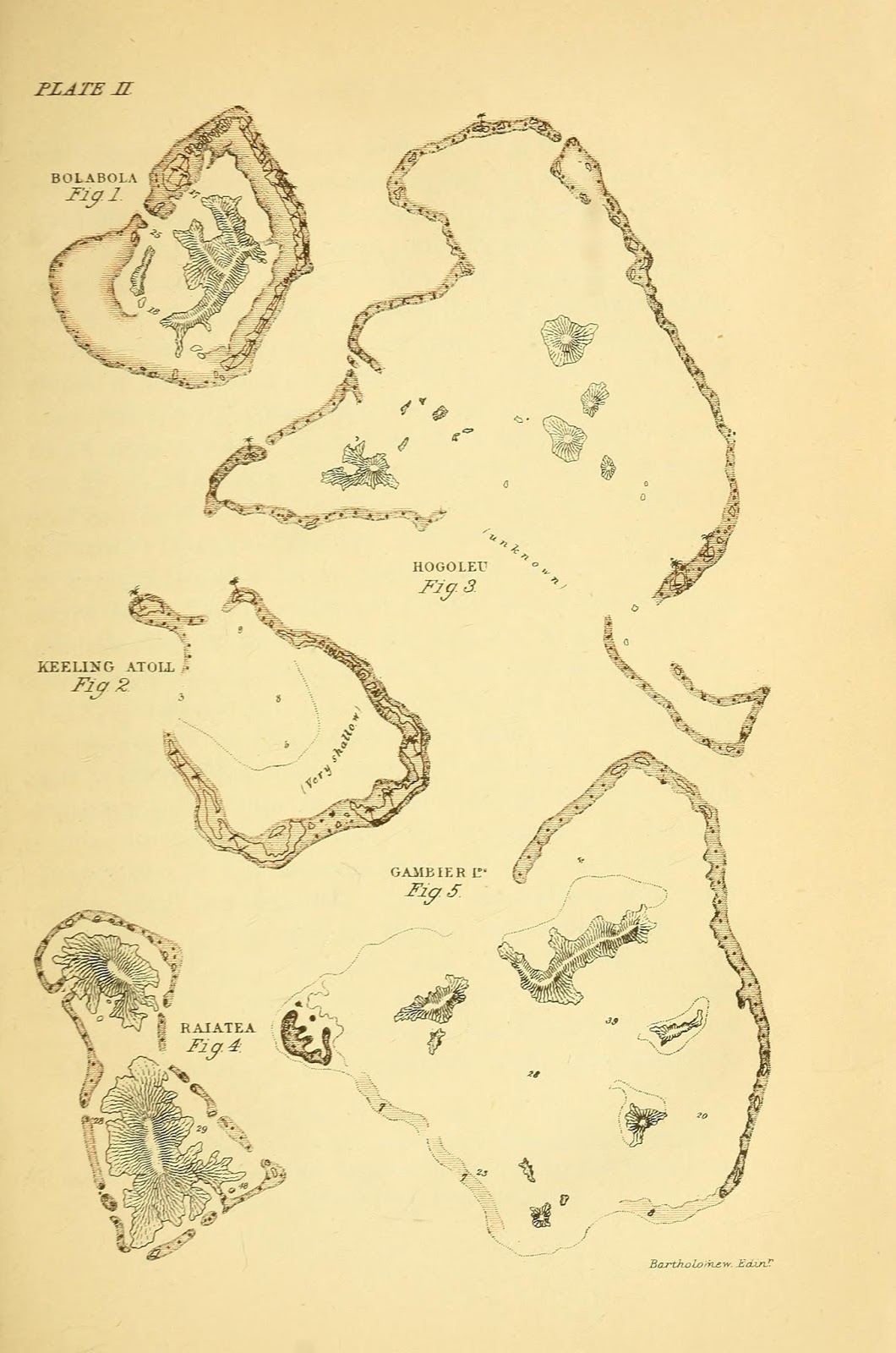 |
| Various atolls illustrated by Darwin. Darwin, Charles. The Structure and Distribution of Coral Reefs. 1842. http://biodiversitylibrary.org/page/40453240. |
The First Textbook on Oceanography: The Physical Geography of the Sea
Oceanography is defined as the study of the ocean, and it can include many topics such as marine life, ocean currents, waves, plate tectonics, meteorology, and many others. Matthew Fontaine Maury, who served in the United States Navy from 1825-61, is sometimes called the “Father of Modern Oceanography and Naval Meteorology.” By studying old ship logs, Maury was able to make important deductions about ocean currents and winds, which resulted in the 1847 publication of Wind and Current Chart of the North Atlantic, which amassed this information to produce a guide to help sailors reduce the length of ocean voyages. Maury also used these ship logs to chart whale migrations, and this research in turn led him to advocate for the existence of a Northwest Passage, through which whales could gain access to both the Atlantic and Pacific Oceans.
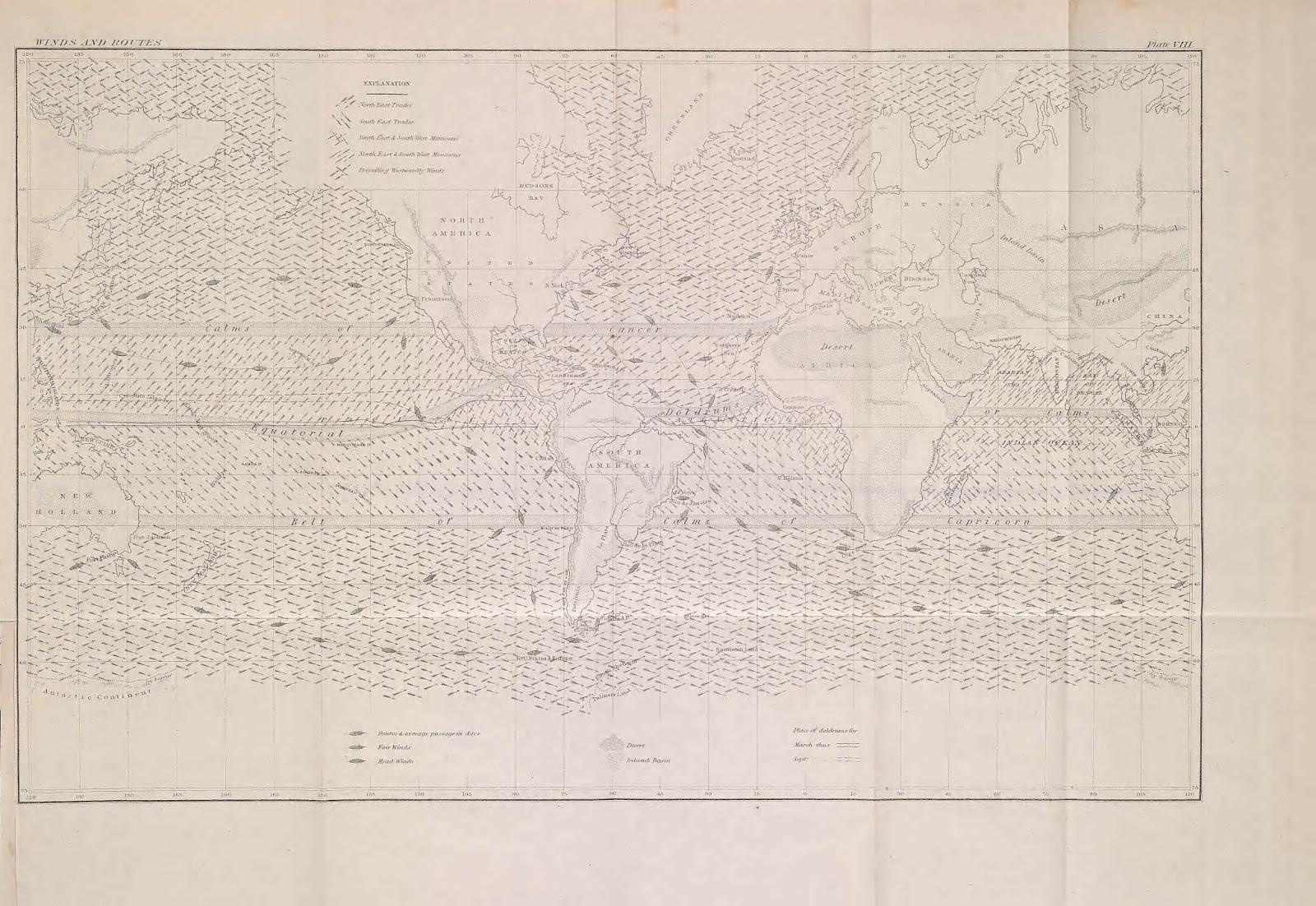 |
| Illustrating various winds, ship passages, and lengths. Maury, Matthew Fontaine. The Physical Geography of the Sea. 1855. http://biodiversitylibrary.org/page/47369923. |
In 1855, Maury published The Physical Geography of the Sea, which is considered the first extensive and comprehensive book on oceanography. As Maury states, the work is “a philosophical account of the winds and currents of the sea; of the circulation of the atmosphere and ocean; [and] of the temperature and depth of the sea” and includes discussions about ocean salinity and many perplexing ocean phenomena, including the Gulf Stream. Although today we know that much of Maury’s science is incorrect, this book helped popularize oceans and the science of the seas and laid the foundation for much of the oceanographic research that followed.
The Foundations of Modern Oceanography: The Challenger Expedition
While the field of ichthyology continued to expand throughout the 16th – 19th centuries, and publications on oceanography including ocean currents and their effects on meteorology appeared in the mid-1800s, even by the 19th century, scientific knowledge about Earth’s watery depths was still very limited. In fact, until the middle of the nineteenth century, many still subscribed to the Abyssal Theory, which stated that life could not exist below about 600 meters (2,000 feet).
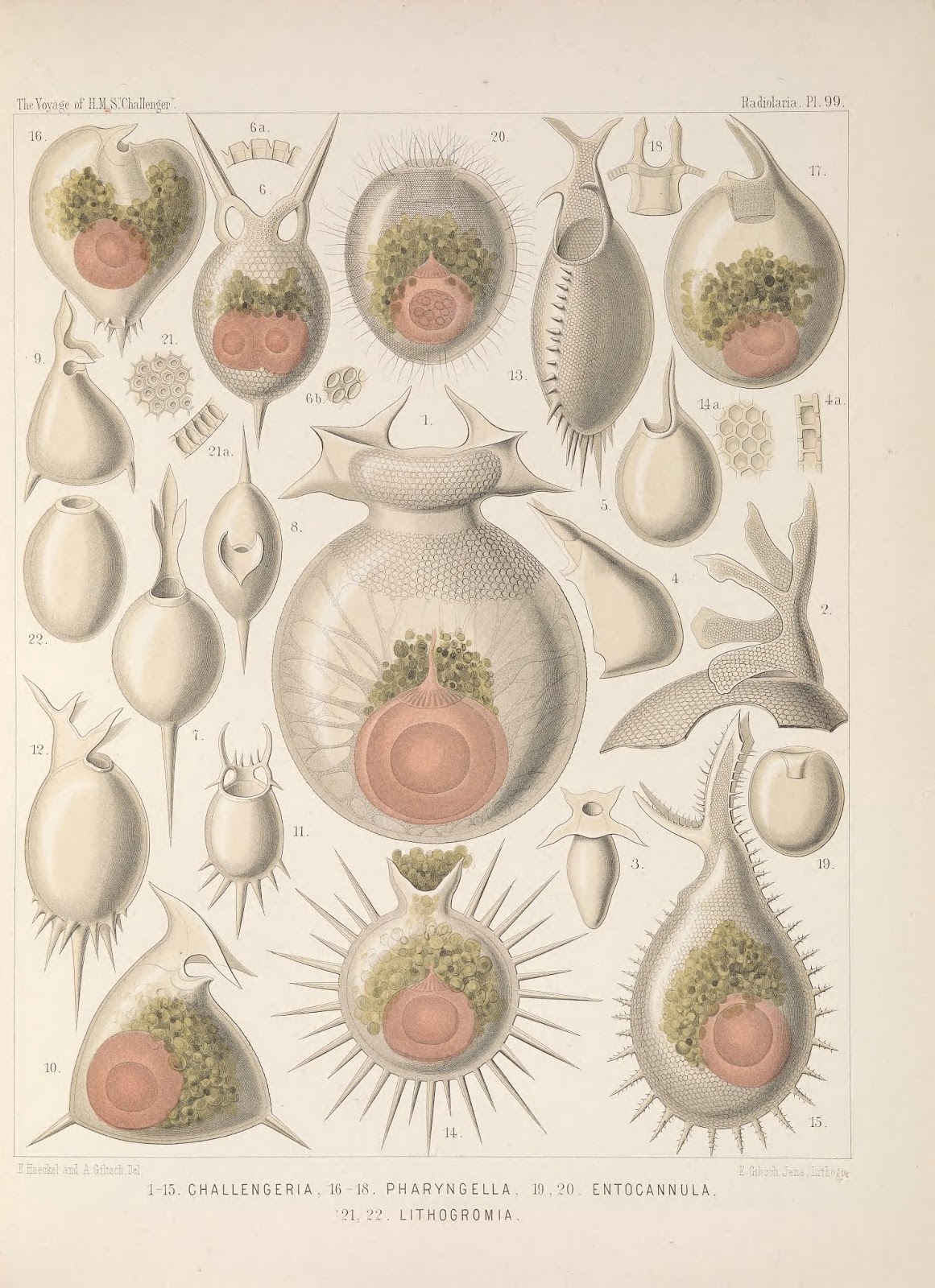 |
| Radiolaria by Ernst Haeckel, collected during the Challenger Expedition. Report on the scientific results of the voyage of H.M.S. Challenger during the years 1873-76. v. 18 plates. 1887. http://biodiversitylibrary.org/page/39632734. |
In 1872, the Royal Society of London launched the first non-commercial exploration of the deep sea – the Challenger Expedition. The purposes of the expedition were to investigate the physical conditions of the deep sea, ascertain the chemical composition of seawater at various depths, determine the physical and chemical character and sources of deep-sea deposits, and investigate the distribution of organic life at different depths. The expedition circumnavigated the globe, traveling nearly 70,000 nautical miles from 1872-76, and resulted in the discovery of nearly 4,700 new-to-science species of marine life, 492 deep sea soundings, 133 bottom dredges, 151 open water trawls, and 263 serial water temperature observations. In 1875, the crew also recorded a sounding of 4,475 fathoms, (8,184 meters), which would later prove to be the southern end of the Mariana trench and one of the deepest known places on the ocean floor. The expedition was monumental in broadening knowledge of the ocean’s depths and species, and revolutionized the field of oceanography.
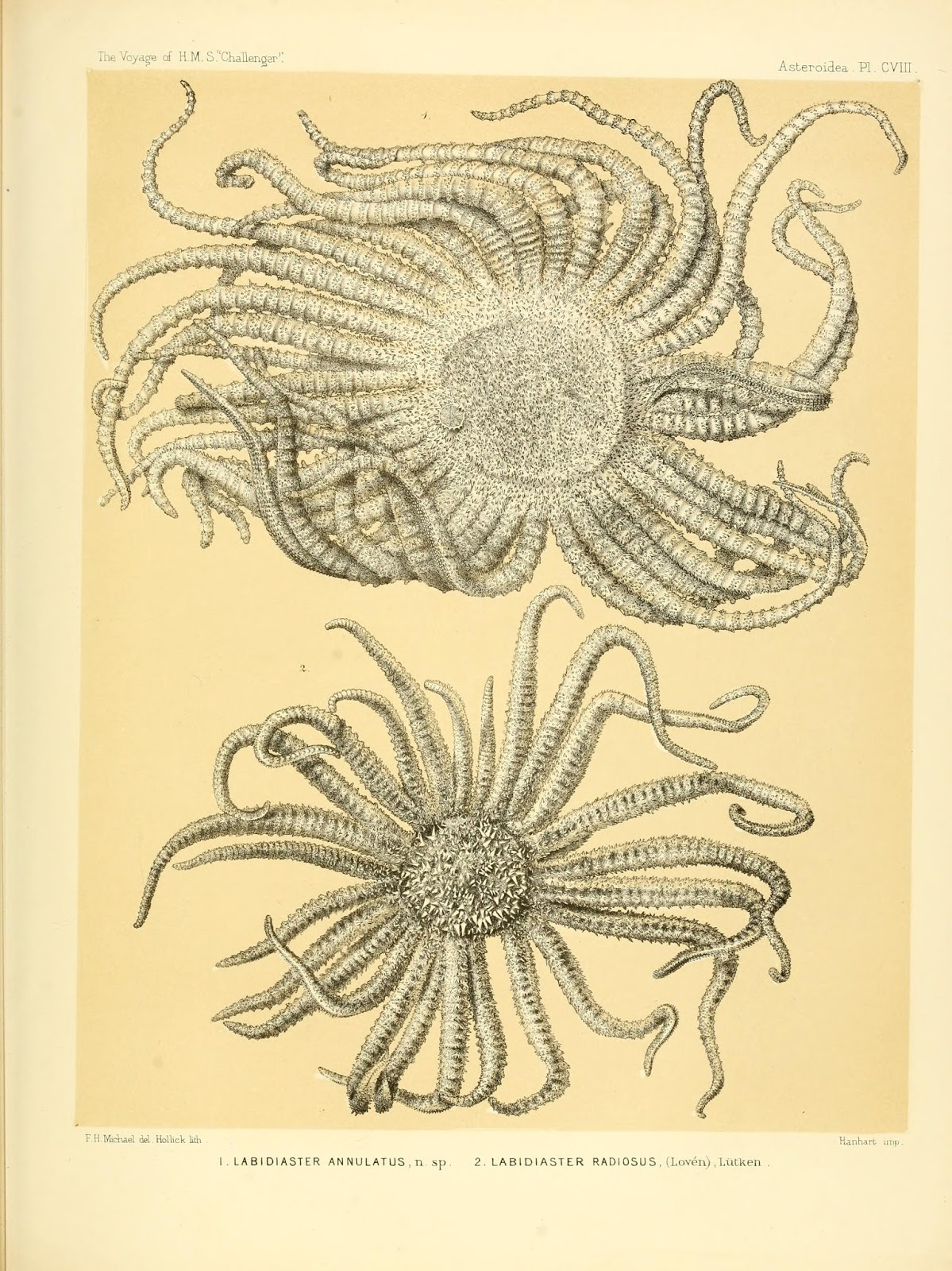 |
| Starfish from Percy Sladen collected during the Challenger Expedition. Report on the scientific results of the voyage of H.M.S. Challenger during the years 1873-76. v. 30 plates. 1887. http://biodiversitylibrary.org/page/25170168. |
The findings from the expedition were published in 50 volumes from 1880-95 as the series Report Of The Scientific Results of the Exploring Voyage of H.M.S. Challenger during the years 1873-76. Sir John Murray, pioneering Scottish oceanographer, described the report as, “the greatest advance in the knowledge of our planet since the celebrated discoveries of the fifteenth and sixteenth centuries.”
Uncovering the Deep Ocean: The Valdivia Expedition
The success of the Challenger Expedition ignited a fever to explore the deep sea and the creatures that called it home. In the late nineteenth century, German marine biologist Carl Chun proposed the first German deep-sea expedition, which was approved by Germany’s last Kaiser, Wilhelm II. In 1898, with national funding, the Valdivia Expedition set sail from Hamburg for the subantarctic seas with a mission to sample, record, and study as many deep-sea organisms and habitats as possible. Covering over 32,000 nautical miles and visiting 268 stations around the West Coast of South Africa, the Gulf of Guinea, the Antarctic Sea, and a large portion of the Indian Ocean, the expedition used the dredging techniques popularized on the Challenger Expedition to collect deep-sea specimens. The expedition was a resounding success, resulting in the discovery of many new deep-sea species, including the vampire squid, which Chun named Vampyroteuthis infernalis, meaning “vampire squid from hell.” The results of the expedition were published over a four-decade period in a 24-volume series entitled Wissenschaftliche Ergebnisse der Deutschen Tiefsee-Expedition auf dem Dampfer “Valdivia” 1898-1899.
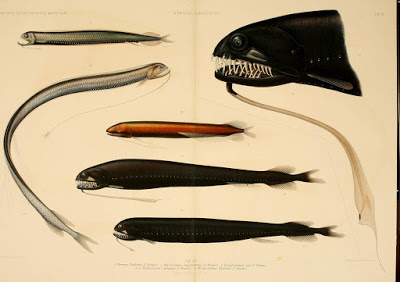 |
| Deep sea fish collected during the Valdivia Expedition. Wissenschaftliche Ergebnisse der Deutschen Tiefsee-Expedition auf dem Dampfer “Valdivia” 1898-1899. Bd. 15, T. 1. 1908. http://biodiversitylibrary.org/page/6002199. |
One of the most important volumes in this series was August Brauer’s report on the deep-sea fishes discovered on the expedition. Published as the series’ fifteenth volume in 1908, Die Tiefsee-Fische is considered the starting point of deep-sea ichthyology. The volume also firmly established the widespread global existence of fish in the bathypelagic zone (depth of 3,300-13,000 feet) and documented the sensory adaptations and bioluminescent capabilities of many deep-sea species. A highlight of the publication are the 44 plates created by the shipboard artist and scientific draftsman Fritz Winter, with whom Brauer collaborated closely to ensure the lifelike, accurate representation of the described specimens.
 |
| Deep sea fish collected during the Valdivia Expedition. Wissenschaftliche Ergebnisse der Deutschen Tiefsee-Expedition auf dem Dampfer “Valdivia” 1898-1899. Bd. 15, T. 1. 1908. http://biodiversitylibrary.org/page/6002204. |
More World Oceans Day Resources
- Follow us on Twitter, Facebook, and this blog all this week as we explore marine biodiversity and awesome related publications in BHL.
- Check out some monumental publications in historic and present-day marine bioscience research in our BHL collection.
- Browse a selection of marine biodiversity illustrations in Flickr and Pinterst





Leave a Comment